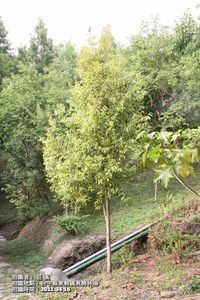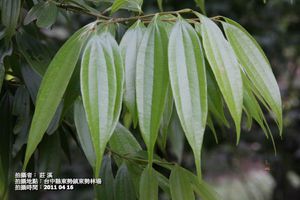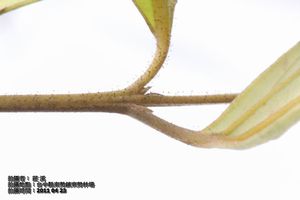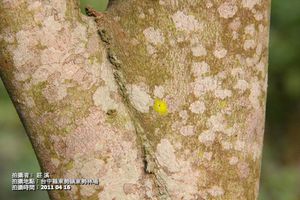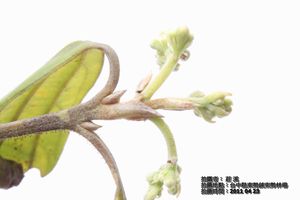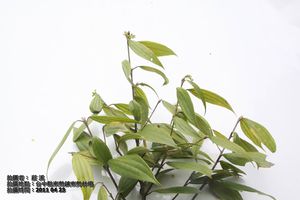香桂
出自台灣有毒中草藥毒性資料庫
| 中英文學名 | 科別 | 毒性 | 症狀 |
基本資料
|
科別 | 樟科 Lauraceae |
|
屬名 | 樟屬 Cinnamomum |
|
中文學名 | 香桂 |
|
拉丁學名 |
Cinnamomum subavenium Miq. Cinnamomum bartheifolium Hayata Cinnamomum randaiense Hayata |
|
英文名稱 | Fragrant Cinnamon, Randaishan Cinnamon-tree |
|
中文俗名 | 巒大香桂、巒大桂、細葉香桂、細葉月桂、細葉肉桂、香樹皮、山肉桂、巒大山肉桂、巒大肉桂、九芎、長果樟 |
植物圖片
|
香桂全株 |
香桂葉 |
香桂嫩枝 | |
|
香桂莖 |
香桂花苞1 |
香桂花苞2 |
香桂簡介
香桂主要產在東南亞一帶,例如緬甸、柬埔寨、中國南方、馬來西亞及印度,在台灣也可發現香桂的蹤跡。香桂有多種具經濟價值的用途,樹皮可提煉精油,供化粧用品等作為添加香精的原料;葉可提煉葉油亦可作食品,香煙的香料,或供做殺菌劑;綠化樹種:可栽植在庭圓、道路作綠化美化或行道樹用;建材或作傢俱用:木質線細,木理通直而稍細緻;乾燥容易,少反翹、開裂,可作建築(門窗、壁板、板類)、器具、枕木用材。
外觀簡述
|
莖 | 中喬木,高可達 20 餘公尺,徑 30~60 公分,樹皮暗褐色;小枝細長,有褐色毛茸,略帶有稜角。 |
|
葉 | 葉剛長出來時有褐色毛茸,老時僅葉背面有褐色的絹毛,長橢圓狀披針形或卵狀橢圓形,長 6~12 公分,寬 2~4 公分,先端漸尖,基部銳或楔形,革質,明顯的三出脈,於表面顯著凹下,背面隆起,表面呈有光澤的綠色,背面有密生毛茸,尤以葉脈處為多;葉柄長 0.7~0.9 公分,有毛茸。 |
|
花 | 花多數,小形,黃綠色,徑約 0.2 公分,呈頂生或腋生的聚繖狀圓錐花序,花序及花梗有白色絨毛,花被片 6 片,橢圓形,長 0.25~0.3 公分,寬 0.15 公分,先端鈍,表裏兩面皆具有毛茸;完全雄蕊 9 枚,花絲具有薄絨毛,花藥橢圓形,背部有微絨毛,第三輪花絲有腺體,腺體近似無柄;退化雄蕊箭形,柄上有絨毛,長 0.06 公分,花藥 4 室,第三輪外向,其他 2 輪內向;子房橢圓形,光滑,長約 0.15 公分,花柱長 0.2 公分,光滑無毛。 |
|
果實 | 果實長橢圓形或橢圓形,長 1.2~1.5 公分,寬 0.5~1 公分,成熟時呈藍黑色;基部襯托先端截斷狀殘存的花被。 |
產地
廣泛分布於印度、緬甸、高棉、越南、馬來西亞、印尼、中國大陸東南(安徽、浙江、江西及福建等地)及台灣。香桂生長於臺灣嘉義以北中海拔 500~2,100 公尺處山區森林中,數量頗多,常為大喬木,佔據森林的上層。
毒性研究
香桂在民俗醫療中主要用於治療腹痛、胸痛、疝氣及腫瘤膨脹等疾病。目前研究發現香桂主要含有的成分為倍半萜類、三萜類、butanolides、多酚類(polyphenol)、固醇類(steroids)[1-8]等。
- 機轉
Chen et al.於2007年自葉部分離出isoobtusilactone A,然後利用HepG2細胞株來進行體外的毒性測試,結果發現isoobtusilactone A可引起劑量相關性的細胞生長抑制,半數抑制劑量IC50為37.5 microM,同時也發現isoobtusilactone A可促進細胞的sub-G1數量及DNA斷裂增多,粒線體膜外cytochrome c濃度也上升導致caspase 3被活化及PARP cleavage而促使細胞凋亡;但在動物實驗中給予350及700 mg/kg的isoobtusilactone A給予5-6週大的Sprague Dawley老鼠,並沒有發現明顯的動物毒性[9]。Liu et al.及Wang et al.於2011年分別各以Subamolide A及E測試其對細胞的毒性,Liu發現subamolide A可促進NTBU1細胞的粒線體改變,透過活化p53及ERK1/2引起細胞凋亡[10];而Wang則發現subamolide E則可影響A375.S2細胞的生長週期,提高sub-G1期的數量,並且透過活化caspase 3, 6, 7, 9及PARP而導致細胞凋亡[11]。
- 毒性成分
- isoobtusilactone A[9]
- Subamolide A[10]
- Subamolide E[11]
治療方式
目前並無任何特殊治療方式,均以支持性療法來治療。
毒性分級
參考文獻
1. Kojima H, Sato N, Hatano A, Ogura H. Sterol glucosides from Prunella vulgaris. Phytochemistry 1990; 29: 2351-2355.
2. Li J, Kadota S, Kawta Y, Hattori M, Xu GJ, Namba T. Constituents of the roots of Cynanchum bungei DECNE.isolation and structures of four new glucosides, bunngeiside-A, -B, -C, and -D. Chemical & Pharmaceutical Bulletin 1992; 40: 3133-3137.
3. Cheng M-J, Tsai I-L, Chen I-S. Chemical constituents from Strychnos cathayensis. Journal of the Chinese Chemical Society 2001; 48: 235-240.
4. Chen CH, Lo WL, Liu YC, Chen CY. Chemical and cytotoxic constituents from the leaves of Cinnamomum kotoense. Journal of Natural Products 2006; 69: 927-933.
5. Chen CY, Chen CH, Wong CH, Liu YW, Lin YS, Wang YD, Hsui YR. Cytotoxic constituents of the stems of Cinnamomum subavenium. Journal of Natural Products 2007; 70: 103-106.
6. Lin RJ, Lo WL, Wang YD, Chen CY. A novel cytotoxic monoterpenoid from the leaves of Cinnamomum subavenium. Natural Product Reseach 2008; 22: 1055-1059.
7. Chen CY, Yang WL, Hsui YR. A novel sesquiterpenoid from the roots of Cinnamomum subavenium. Natural Product Reseach 2010; 24: 423-427.
8. Shen KH, Lin ES, Kuo PL, Chen CY, Hsu YL. Isolinderanolide B, a butanolide extracted from the stems of Cinnamomum subavenium, inhibits proliferation of T24 human bladder cancer cells by blocking cell cycle progression and inducing Apoptosis. Integrative Cancer Therapies 2010.
9. Chen CY, Liu TZ, Chen CH, Wu CC, Cheng JT, Yiin SJ, Shih MK, Wu MJ, Chern CL. Isoobtusilactone A-induced apoptosis in human hepatoma Hep G2 cells is mediated via increased NADPH oxidase-derived reactive oxygen species (ROS) production and the mitochondria-associated apoptotic mechanisms. Food and Chemical Toxicology 2007; 45: 1268-1276.
10. Liu CH, Chen CY, Huang AM, Li JH. Subamolide A, a component isolated from Cinnamomum subavenium, induces apoptosis mediated by mitochondria-dependent, p53 and ERK1/2 pathways in human urothelial carcinoma cell line NTUB1. Journal of Ethnopharmacology 2011; 137: 503-511.
11. Wang HM, Chiu CC, Wu PF, Chen CY. Subamolide E from Cinnamomum subavenium induces sub-G1 cell-cycle arrest and caspase-dependent apoptosis and reduces the migration ability of human melanoma cells. Journal of Agricultral and Food Chemistry 2011; 59: 8187-8192.
| 中英文學名 | 科別 | 毒性 | 症狀 |
